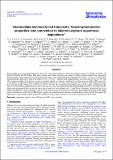Por favor, use este identificador para citar o enlazar a este item:
http://hdl.handle.net/10261/260831COMPARTIR / EXPORTAR:
 SHARE SHARE
 CORE
BASE CORE
BASE
|
|
| Visualizar otros formatos: MARC | Dublin Core | RDF | ORE | MODS | METS | DIDL | DATACITE | |

| Título: | Intermediate-luminosity red transients: Spectrophotometric properties and connection to electron-capture supernova explosions |
Autor: | Cai, Y. Q.; Elias-Rosa, Nancy CSIC ORCID; Galbany, Lluís CSIC ORCID ; Young, D. R. | Palabras clave: | Supernovae: general Stas: AGB and post-AGB Stars: mass-loss |
Fecha de publicación: | 27-oct-2021 | Editor: | Springer Nature | Citación: | Astronomy & Astrophysics 654: A157 (2021) | Resumen: | We present the spectroscopic and photometric study of five intermediate-luminosity red transients (ILRTs), namely AT 2010dn, AT 2012jc, AT 2013la, AT 2013lb, and AT 2018aes. They share common observational properties and belong to a family of objects similar to the prototypical ILRT SN 2008S. These events have a rise time that is less than 15 days and absolute peak magnitudes of between-11.5 and-14.5 mag. Their pseudo-bolometric light curves peak in the range 0.5-9.0 × 1040 erg s-1 and their total radiated energies are on the order of (0.3-3) × 1047 erg. After maximum brightness, the light curves show a monotonic decline or a plateau, resembling those of faint supernovae IIL or IIP, respectively. At late phases, the light curves flatten, roughly following the slope of the 56Co decay. If the late-time power source is indeed radioactive decay, these transients produce 56Ni masses on the order of 10-4 to 10-3 M⊙. The spectral energy distribution of our ILRT sample, extending from the optical to the mid-infrared (MIR) domain, reveals a clear IR excess soon after explosion and non-negligible MIR emission at very late phases. The spectra show prominent H lines in emission with a typical velocity of a few hundred km s-1, along with Ca II features. In particular, the [Ca II] λ7291,7324 doublet is visible at all times, which is a characteristic feature for this family of transients. The identified progenitor of SN 2008S, which is luminous in archival Spitzer MIR images, suggests an intermediate-mass precursor star embedded in a dusty cocoon. We propose the explosion of a super-asymptotic giant branch star forming an electron-capture supernova as a plausible explanation for these events. | Descripción: | Cay, Y. Z., et al. | Versión del editor: | http://doi.org/10.1051/0004-6361/202141078 | URI: | http://hdl.handle.net/10261/260831 | DOI: | 10.1051/0004-6361/202141078 | Identificadores: | doi: 10.1051/0004-6361/202141078 issn: 1432-0746 |
| Aparece en las colecciones: | (ICE) Artículos |
Ficheros en este ítem:
| Fichero | Descripción | Tamaño | Formato | |
|---|---|---|---|---|
| supernova-explosions.pdf | 4,81 MB | Adobe PDF |  Visualizar/Abrir |
CORE Recommender
SCOPUSTM
Citations
16
checked on 04-may-2024
WEB OF SCIENCETM
Citations
15
checked on 29-feb-2024
Page view(s)
39
checked on 12-may-2024
Download(s)
16
checked on 12-may-2024
Google ScholarTM
Check
Altmetric
Altmetric
NOTA: Los ítems de Digital.CSIC están protegidos por copyright, con todos los derechos reservados, a menos que se indique lo contrario.
